AI: Recipe for Success?
Grade 6
Presentation
Hypothesis
Testable Question
How do the outcomes from recipes different AI models provide vary in taste, look, and feel?
Hypothesis
If AI is trustworthy most of the time, then the recipes we make will give us ideal outcomes, as the credibility of AI suggests it gives some great advice.
Research
BASICS
What is AI, and what is its histoy?
AI, or Artificial Intelligence, is designed to meet our needs, ranging from solving everyday problems to generating important business ideas. It is programmed to 'think like a human' and is now used widely. In the past, AI was limited to responding to simple questions, giving recommendations, and learning. Today, however, its capabilities have expanded significantly, from creating images to generating prompts for music and literature, and even generating recipes.
· Artificial Intelligence (1950's) ·
Artificial intelligence allows machines to copy human thinking, learning, and decision-making. AI can learn from experience and give recommendations, sometimes even working on its own—like a self-driving car.
Some important dates in AI's history during this time period include:
- The 'birth' of AI. This started in 1950, when Alan Turing, a renowned computer scientist and cryptanalyst decided to perform a test (later named as the Turing Test) to determine if a machine could speak like a human would.
- Just five years after Turing proposed the Test, computer and cognitive scientist John Mcarthy introduced a summer workshop at Dartmouth College along with the term "artificial intelligence"-- which later came into popularity decades after.
- In 1959, computer scientist Arthur Samuel created the term "Machine Learning" during a speech about teaching machines to play chess better than their developers. After another three years, in 1958, McCarthy created the language LISP (List Processing) which is still an accepted language even to this day.
- In 1965, the first "expert system" was introduced to the public, as a form of AI programmed to replicate the abilities of human experts.
- ELIZA, a mock psychotherapist created in 1966, was the first chatbot developed to converse with humans.
- Mathematician Alexey Ivakhnenko proposed a new approach to AI in 1968, which would later on be known as "Deep Learning".
- In 1979, the American Association of Artificial Intelligence which is now known as the Association for the Advancement of Artificial Intelligence (AAAI) was founded.
Based on the famous Turing Test, "Human or Not" is a game where players chat for a limited time and later have to determine whether they chatted with a human or bot.
· Machine Learning (1980's) ·
Machine learning trains algorithms to make decisions using data without being specifically programmed for tasks. There are numerous types of machine learning, but one type is supervised learning, where labeled data is used to train the program.
Some important dates in AI's history during this time period include:
- In 1985, the first automated drawing program named AARON was introduced at an AAAI conference.
- The first driverless car was introduced in 1986 by Ernst Dickmann and his team at Bundeswehr University of Munich.
- Alacrity, a strategic advisory system, was presented to the public in 1987 as a complex expert system with over 3000 rules.
- In 1998, chatbot Jabberwacky was invented to provide more interesting and entertaining conversations.
- In 2003, NASA sent two rovers to Mars, tasked with navigating the planet without any human help.
- Apple's Siri was released to assist virtual navigation in 2011.
· Deep Learning (2010's) ·
Deep learning uses neural networks that work like human brains when making decisions. They are programmed to learn from large data without human help or intervention, and they are great for tasks like recognizing images (for example, to tell whether the provided image is of a cat or not) and finding patterns in data quickly.
Some important dates in AI's history during this time period include:
- In 1985, the first automated drawing program named AARON was introduced at an AAAI conference.
- The first driverless car was introduced in 1986 by Ernst Dickmann and his team at Bundeswehr University of Munich.
- Alacrity, a strategic advisory system, was presented to the public in 1987 as a complex expert system with over 3000 rules.
- In 1998, chatbot Jabberwacky was invented to provide more interesting and entertaining conversations.
- In 2003, NASA sent two rovers to Mars, tasked with navigating the planet without any human help.
- Apple's Siri was released to assist virtual navigation in 2011.
- Many AI developers and those involved with AI signed an open letter in 2015, banning improper development and use of AI in war.
- In 2016, Sophia, the first robot with a humanoid appearance, was created to replicate human emotions and communication.
· Generative AI (2020's) ·
Generative AI uses Deep Learning to provide the user with original content and they often make similar(yet not totally the same) things from other data.
Some important dates in AI's history during this time period include:
-
In 2020, OpenAI beta tested GPT-3, which can create code, poetry, art, writing, and more.
-
In 2021, OpenAI introduced DALL-E, an AI model designed to process and understand images for better results.
How do we program and improve AI?
The important question is-- How do we program AI? AI isn’t exactly programmed the same way as traditional computer programming, which doesn’t update and improve itself. You first need to know what you are designing your AI system for. Then, do research, prepare and test your algorithm, make changes to improve it, choose your programming platform, and program your AI. AI might not be right all the time. So, how do we improve it? By giving feedback and training it over, and over, and over again, it will be experienced in no time! An important key in programming a successful AI is to collect more relevant data to train the AI model.
AI can be programmed in Python, Java, R, and Julia. These languages are great for data analysis, language processing, math, and machine learning, but each one has unique features for different tasks. After picking a language, the programmer decides what their AI program does. For example, the goal might be a fully functional image creator. If they want to make an image creator, they must also train the program with countless drawings, pictures, and more. This applies to any other type of project goal. After that, the programmer has to consider key points for having a fair and accountable AI, including understanding its weaknesses and strengths. Last but not least, before deploying the tool, the creator must provide the AI with relevant and detailed prompts to enhance the model and fix any remaining bugs.
Why is AI significant to our lives?
AI is here to meet our everyday needs. Although it is not right all the time, it is a very useful resource that gives you tips for almost everything. Whether you need a happy fairytale to brighten your day or inspiration for your new art masterpiece, you can trust AI to create the best results.
Here are some interesting things AI can do!
- Online Shopping Help
- Research
- Answer Questions
- Create Daily Routines
- Recommendations
- Translations
- Cars, Homes, and More
- Help Recognize Cyberattacks
- Correcting Misinformation
- Create Images, Stories, Poems, Songs, and More
- Editing Images and Videos
- Basic Therapy
EXPANSION
How can we use AI correctly?
AI can do various things, but there are some precautions to using it. Make sure to identify bias, privacy risks, and *ethical problems. To identify bias, always look for personal opinions given by the AI. Never give your own personal information. We can also evaluate some key points like fairness, accountability, security, transparency, education, and relevance— also known as F.A.S.T.E.R. This contributes to how we can identify if AI is good or not, therefore suggesting its trustworthiness.
*ethical is just a fancy word for moral.
Here is an outline of the F.A.S.T.E.R. principal;
Fair
We want to make sure information given by AI doesn't include serious personal or cultural biases. Checking that the info provided is fair is also a key point.
Accountability
We have to make sure that results given by AI are accurate, legal, and ethical before using or taking action; which means we should always double-check the info before making decisions.
Security
Sometimes AI might be or provide sources that aren't the most credible, so make sure they are safe before providing personal info or anything that threatens your privacy.
Transparency
Make sure you know when content has been created by AI and what's not. The AI should let users know that they are interacting with an AI tool and how to use the program correctly.
Education
We have to spot the weaknesses and strengths in AI, and make sure the results are clear and specific.
Relevance
Using different AI systems that meet your needs is important; we don't want to ask for images on a business-based system. We also have to recognize the limits of AI and that the tools sometimes might not be the best option for everything. We should also consider the impact before choosing to use a specific tool.
How is AI different from how humans think?
Is AI really capable of doing what humans are supposed to do? The answer is pretty clear—probably not. AI can make decisions with the information given, but that’s just about it. AI is programmed to imitate humans in how we act, feel, speak, and decide. It never really gets tired, which means AI is fit for more repetitive and lower-level routine tasks.
On the other hand, humans’ abilities are more expansive, as humans can feel, imagine, anticipate, and judge principles. This type of intelligence is unique to humans, allowing them to shift from short-term to long-term concerns. This type of intelligence is called Authentic Intelligence, while AI is called, well—Artificial Intelligence. But are the two really that different? No, actually! We can combine the two intelligences to make a better one, which uses the unique and astonishing abilities of both. We can create a new intelligence that has all the pros of the two—Augmented Intelligence. This raises the question of whether AI can ever replace humans.
Variables
Manipulated variable:
-different types of cookies (eg. flavour, texture, size)
Responding variables:
-recipes & cookies/result (efficiency, creativity, ect.)
-time span of process
Controlled variables:
-AI models ChatGPT, Perplexity AI, and Microsoft Copilot
-cookie recipes
-ingredients and materials
-oven heat
*Note: Even though this project has some experimental components, it's mainly about exploring a "hot question." This means not all variables will be strict and totally controlled.
Procedure
Step 1: Hypothesis
An educated guess that leads the way. What are we aiming for? We could use the “If, then, because,” statement. Our Hypothesis is, "If AI is trustworthy most of the time, then the recipes we make will give us ideal outcomes, as the credibility of AI suggests it gives some great advice."
Step 2: Research
We need to research background information on AI in order to fully understand this concept and how it works. Some questions we researched were "What is AI?", "History of AI", "Programming and Development of AI", "Why is AI significant?", and more. We learned quite a lot about AI in this step, making it easier to identify mistakes and find solutions in the future.
Step 3: Collecting Recipes
Collect the AI models, which are ChatGPT, Perplexity AI, and Microsoft Copilot. We generated the recipes and baked them! We could have repeated it multiple times, but we didn't have a handful of time to redo it. Our prompt was, "Can you generate a unique and simple recipe for six small cookies?" We generated multiple recipes from each AI, analyzed which one would've worked, and picked out the final three below.
Here are our recipes:
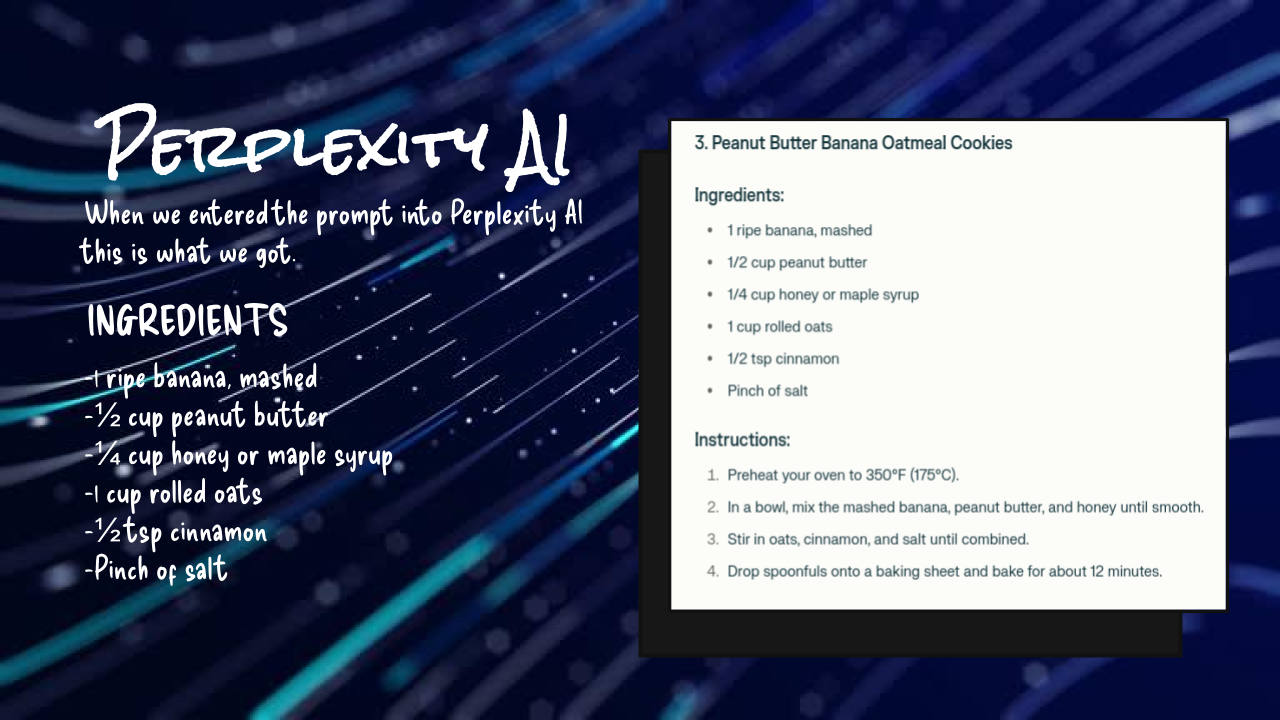
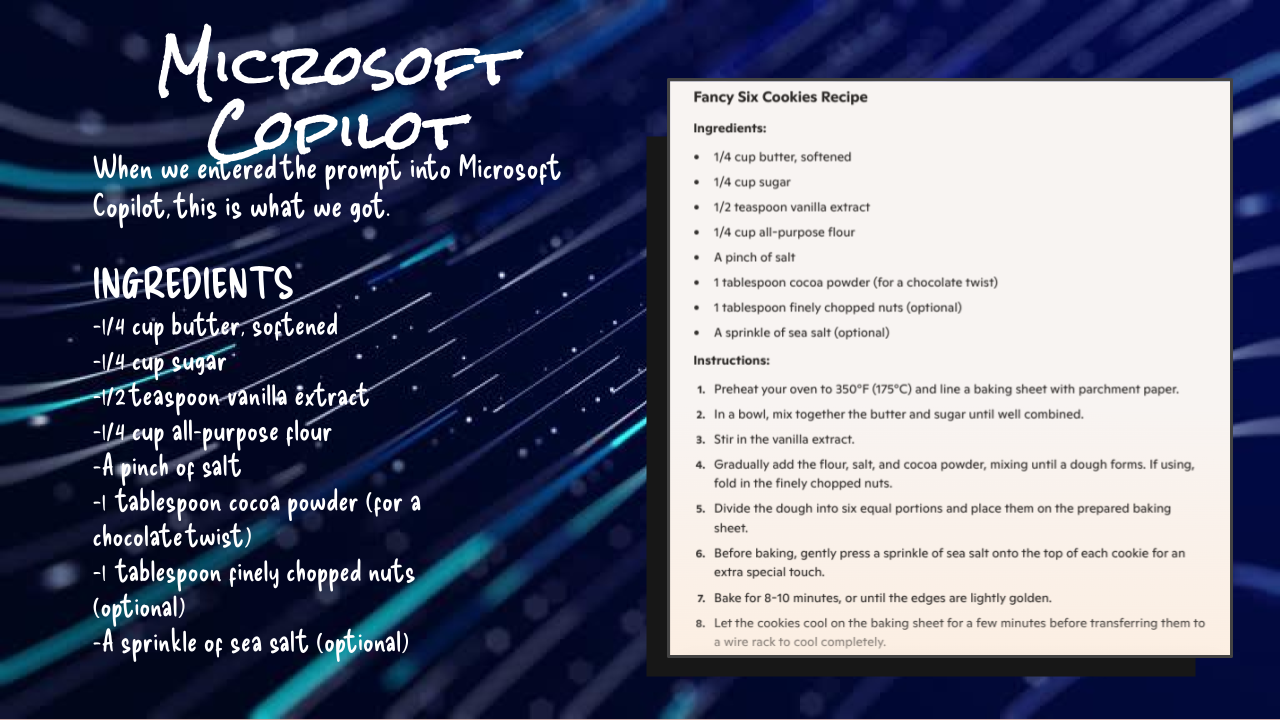

Step 4: Testing and Ranking
We tested all the recipes, and decided which recipe is the best based on creativity and the overall result. We also ranked the cookies based on taste, efficiency, looks and creativity.
Here are our recipe results!
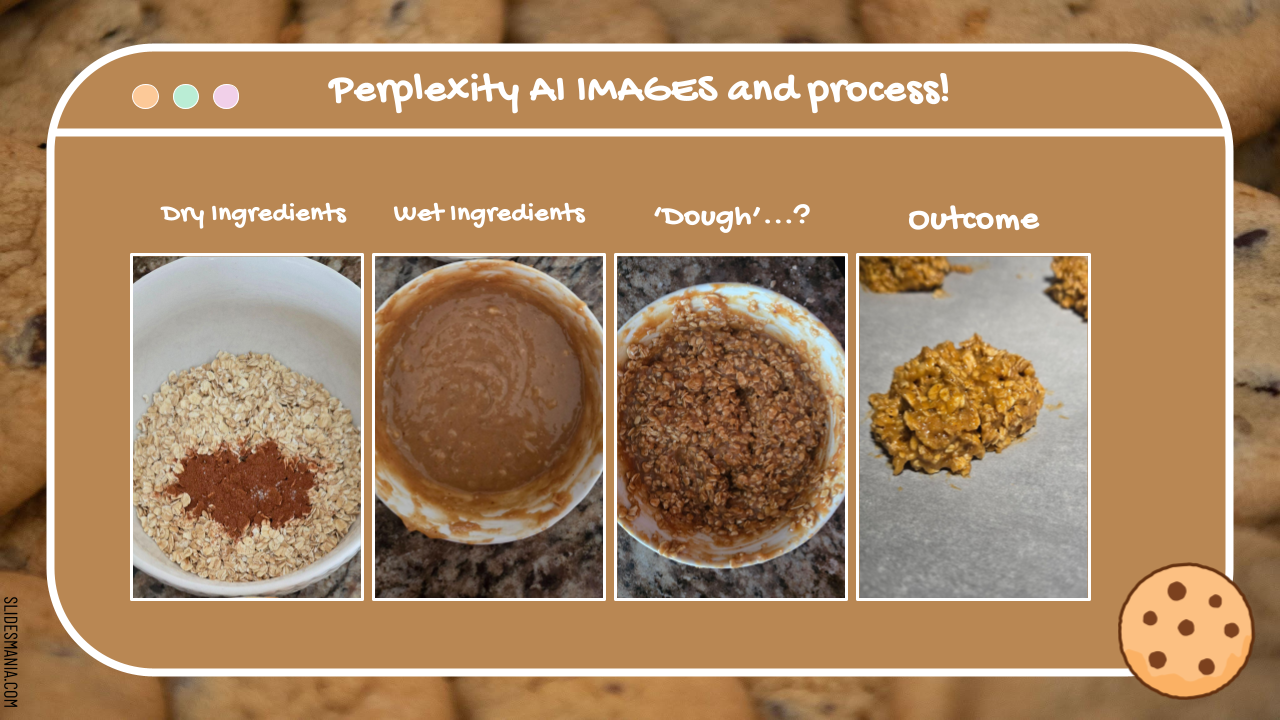
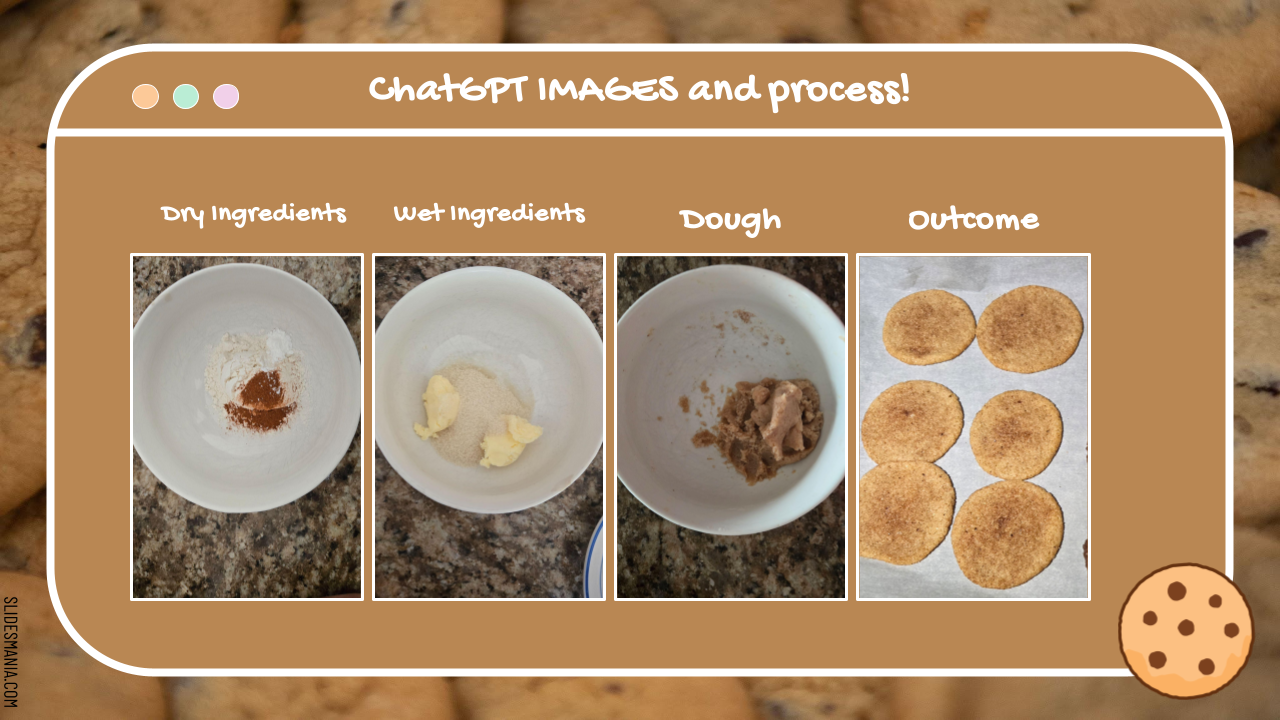
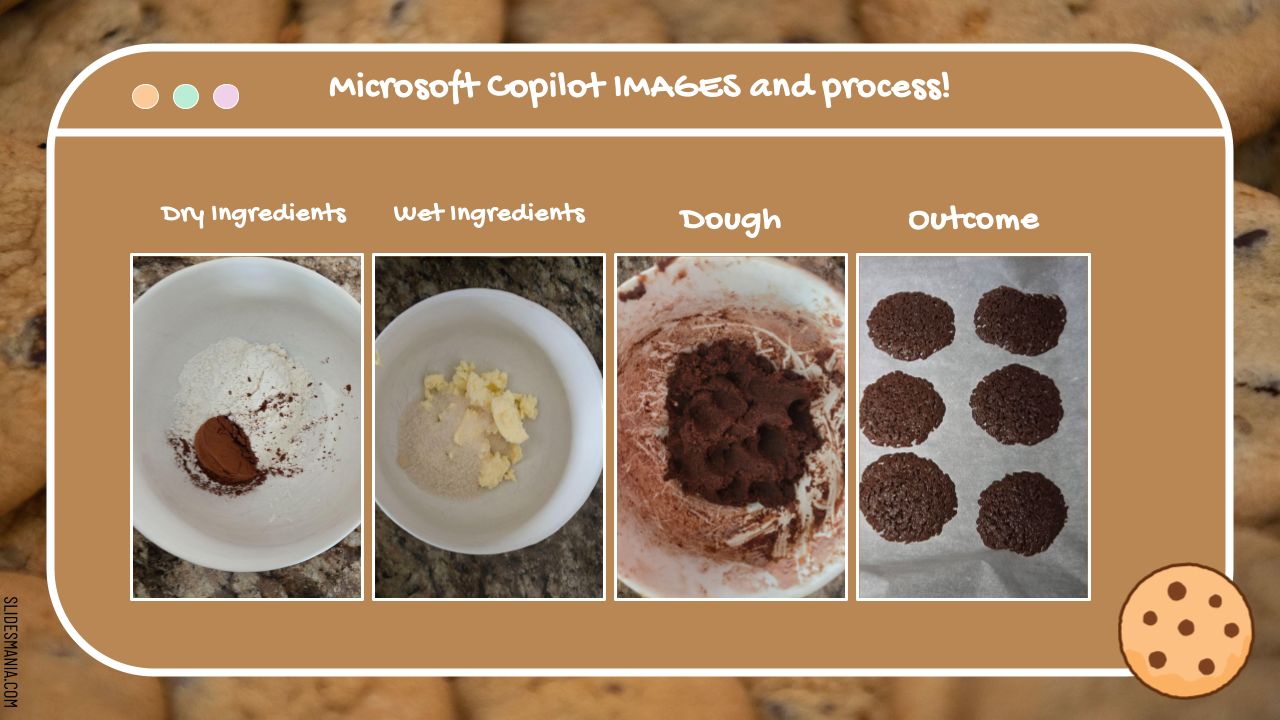
After tasting them and analyzing the process, we came up with charts ranking the cookies.
Step 5: Conclusion and Reflection
We analyzed what each AI did the best, how efficient the process was, and the resulting cookie.
Step 6: Extension
What are our extensions? First, if a recipe didn’t work, we will try to figure out why. Then, we would like to build on this project and recognize our mistakes and what we could've changed.
Observations
Chat GPTCookies:
-
Didn't require eggs, unlike most cookie recipes.
-
The cookies turned out very thin.
-
Flavor was a bit too sweet.
-
Needed very few ingredients.
-
Looked appetizing.
-
Very strong cinnamon taste.

Microsoft Copilot Cookies:
-
No eggs were needed.
-
The instructions were very detailed.
-
Cookies had cracks everywhere.
-
Strong chocolate flavor, probably because of the cocoa powder.
-
The final result felt less fancy than the name suggested.
-
Without cocoa powder, it’s basically a butter cookie.

Perplexity AI Cookies:
-
Did not require eggs.
-
The insides were undercooked, while the bottoms were slightly burnt.
-
The recipe made too much batter for just six cookies.
-
Cookies were super thick and tasted like bread.
-
Extremely sweet.
-
Ingredients were odd but creative.
-
Could be a healthy snack.

Analysis
Our goal in this project is to determine whether or not AI should be allowed to perform everyday tasks, like creating recipes or yoga routines. To conduct this experiment, we asked AI to generate recipes and judged them based on creativity and the efficacy of the outcomes. Since we already know that AI is extremely popular and widely used around the world, we assumed and predicted that AI should be able to give us a satisfying result.
In order for us to completely understand the trustworthiness of AI, we decided to incorporate a fun project of baking with the hot question, "How do the outcomes from recipes provided by different AI models vary in taste, look, and feel?"
Our hypothesis was: "If AI is trustworthy most of the time, then the recipes we make will give us ideal outcomes, as the credibility of AI suggests it provides great advice." Our hypothesis was partly correct, as the recipes all resembled cookies and were very creative. Yet, during our research, we learned that we should use AI models according to our needs—for example, Perplexity AI is programmed for making citations and doing research. That could explain why the cookies we made from recipes generated by Perplexity AI didn't work out well.
Before baking the cookies, we analyzed them into a table by just looking at the recipe itself. We were pre-judging them based on creativity, efficiency, and our first impression on the recipe.
|
AI / Property |
ChatGPT: OVERALL #1 |
Perplexity AI: OVERALL #2 |
Microsoft Copilot: OVERALL #3 |
|
Name / First Impression |
#1: Really fun name |
#2: Sensible name |
#3: Boring name |
|
Length / Efficiency |
#1: Really long recipe |
#3: Short recipe |
#2: Long recipe |
|
Ingredients / Creativity |
#2: Not-so-creative ingredients |
#1: Fun and interesting |
#3: Typical ingredients |
After baking and trying our cookies, we analyzed them into tables.
|
AI / Property |
ChatGPT: OVERALL #1 |
Perplexity AI: OVERALL #3 |
Microsoft Copilot: OVERALL #2 |
|
Taste |
#2: Pretty good taste, slightly sweet |
#3: Disgusting |
#1: Delicious and satisfying |
|
Looks |
#1: Very ‘cookie like’ appearance and looked appetizing |
#3: Chunky and not visually pleasing |
#2: Crackly but it had a ‘cookie like’ appearance |
|
Total Time Consuming |
#1: Shortest time |
#3 : Longest time |
#2: Medium time overall |
This means that ChatGPT was the most relevant out of all AI tools if you want to generate something creative, like a cookie recipe! We learned that AI is a significant part of doing daily tasks, but it can only provide tips and information—while the important job is meant for us, the humans.
Conclusion
All the recipes worked in some way; ChatGPT’s cookies looked great but tasted dry and too sweet. Perplexity AI's cookies were a bit of a disappointment. The bananas were hard to mash, which took a lot of time, and the ingredients didn’t make sense because there was no flour, baking soda, or anything like a normal cookie. It was pretty creative, though! Microsoft Copilot’s cookies had some cracks. We’re not sure if they were supposed to look that way since the recipe didn’t specify the final result. The cracks might have happened because we pressed the dough too flat before baking.
At the end of the day, all the AIs did okay, and all the recipes were edible. However, Perplexity AI’s cookies didn't turn out the best since they tasted pretty bad and were hard to make. On the other hand, ChatGPT did a great job of making sure the cookies were both creative and delicious.
This means that AI can be trusted to handle simple tasks like making a recipe or generating images, but it’s not reliable enough yet to make significant decisions. It shows that AI probably won’t be able to replace humans, but it can definitely work with us to come up with better solutions. To wrap this up, in this experiment, we learned the secrets of AI, how to use AI correctly, and when to use AI effectively. This project was successful despite some major and minor mistakes, and we learned a lot about this mysterious and interesting concept!
Next time, we would like to give feedback to the AI systems about how the recipes worked out and how they didn’t. We wonder if it would affect the AI's future performance and if we could get a better result after providing our feedback. For instance, we could tell Perplexity AI that the proportions were way too much for just six cookies and ask it to improve the recipe. We also want to ask the AI for other recipes, craft ideas, and even math problems to get more accurate results. Another idea is to test the systems with challenges, like making recipes with limited ingredients or for people with allergies. This would show how well they can handle different situations. For example, we could ask for a recipe without gluten or dairy and see how the AI adjusts.
In conclusion, this project was an exciting way to explore AI's capabilities. We recognized its strengths and weaknesses; for example, AI is extremely creative but makes occasional mistakes. We can tell that AI isn't 100% perfect, but we know it is a great tool that supports and inspires us when used correctly. This project was just a small glimpse of what AI can really do, and we are excited to see what it further offers us.
Application
Knowing when and how to use AI is important in both virtual and real life. We need to recognize that AI shouldn't be used for certain tasks, while other tasks might work out better with AI's help. For example, we don't want to use AI for homework, as it doesn’t really help with your learning—and sometimes, AI makes mistakes. But if you want a creative story or a joke to cheer you up, AI is the way to go!
We learned that AI can be trusted to handle many tasks, but we still need to keep improving it and learning how to spot its mistakes.
Sources Of Error
For the most part, we didn't make any major errors that could've completely impacted the experiment. One obvious error we made was in measuring the ingredients. Even though we tried our best to get it exactly right, it was nearly impossible since there were instructions like "a pinch of salt" or "a sprinkle of sea salt" in the recipes. Our "pinches of salt" could have affected the cookie, the baking, or the taste, but again, it was unavoidable.
Another error we made was when we were rolling and pressing down on the dough of the "Microsoft Copilot Cookie." We might have pressed it too flat, which caused the cracks on the cookie. The exceptional amount of sea salt we sprinkled on the cookie could also have caused the cracks when it melted. We could've reduced the amount of sea salt to just a little or even none, which might have given us a different result.
Some additional, minor errors we encountered included not using a more precise prompt, which might have given us a more acceptable result. We should've made a precise prompt, even if our goal was to "let the AI do its work with no interference." One possible prompt could've been: "Can you generate a unique and simple recipe for six small chocolate cookies?" We also could have recorded the other samples generated using the same prompt, which would've made it much easier for us to compare and infer how the results would vary.
Citations
Research and Applications
-
IBM (9 August 2024): What is artificial intelligence (AI)? —https://www.ibm.com/think/topics/artificial-intelligence
-
European Parliament (04-09-2020): What is artificial intelligence and how is it used? —https://www.europarl.europa.eu/topics/en/article/20200827STO85804/what-is-artificial-intelligence-and-how-is-it-used
-
Sharp (May 12th 2023): 10 interesting facts about AI —https://www.sharp.co.uk/news-and-events/blog/10-interesting-facts-about-ai
-
Tableau (n.d.): What is the history of artificial intelligence (AI)? —https://www.tableau.com/data-insights/ai/history
-
New Scientist (n.d.): Alan Turing | The father of modern computer science —http://www.newscientist.com/people/alan-turing/
-
Computer History Museum (n.d.): John McCarthy —https://computerhistory.org/profile/john-mccarthy/
-
Medium (Jan 3, 2024): How to build an AI system? A complete guide —https://medium.com/@sphinxshivraj/how-to-build-an-ai-system-a-complete-guide-120d67230be1
-
Upwork (Aug 28, 2024): What is AI programming? Exploring applied uses —https://www.upwork.com/resources/ai-programming
-
Government of Canada (2024-10-15): Guide on the use of generative artificial intelligence —https://www.canada.ca/en/government/system/digital-government/digital-government-innovations/responsible-use-ai/guide-use-generative-ai.html
-
Elegant Themes (January 7, 2025): What can AI do? 15 common uses in 2025 —https://www.elegantthemes.com/blog/business/what-can-ai-do
-
HBR (March 18, 2021): AI should augment human intelligence, not replace it —https://hbr.org/2021/03/ai-should-augment-human-intelligence-not-replace-it
Miscellaneous
-
OpenAI (N/A): ChatGPT —https://chatgpt.com/
-
Perplexity AI (N/A): Perplexity AI —https://www.perplexity.ai/
-
Microsoft (N/A): Microsoft Copilot —https://copilot.microsoft.com/
-
YouTube (Mar 1, 2023): How to do a science fair project —https://www.youtube.com/watch?v=xcsIbotRdc4
-
Human or Not (N/A): Human or Not? —https://www.humanornot.ai/
-
Trent University (n.d.): Paraphrasing and summarizing —https://www.trentu.ca/academicskills/how-guides/how-use-sources/avoiding-plagiarism/paraphrasing-and-summarizing
-
HBR (June 2013): How to give a killer presentation —https://hbr.org/2013/06/how-to-give-a-killer-presentation
-
Canva (N/A): Canva —https://www.canva.com/
-
Purdue Online Writing Lab (n.d.): APA formatting and style guide —https://owl.purdue.edu/owl/research_and_citation/apa_style/apa_formatting_and_style_guide/index.html
Acknowledgement
First of all, we would like to thank our amazing teachers for supporting us and helping us throughout our journey. Mrs. Murphy and Mrs. Metcalfe, our awesome SMATH teachers, provided us with valuable feedback and a whole new perspective on this project. We recognize the hope, trust, and hard work you put into us. All those countless lunch hours were not wasted!
Mr. Groves, you were with us and our idea from the very beginning. From when we proposed our project idea to when we got into the Science Fair, you were always there to say, "You did amazing," and, "Something you could have improved on is..." Cheers to the beard!
We also recognize the huge help from Ms. Davis, our Science Fair Coordinator, who answered our unnerving number of questions about the Science Fair. The judges who evaluated our presentation gave us exceptional feedback and helped broaden our knowledge.
Thank you tremendously to our parents, who never complained about the mess we made and even took the time to evaluate our presentation. They were extremely helpful, keeping us on task and helping us finish the project efficiently.
Special thanks to our classmates, who never let us down, always complimenting us, giving extremely useful feedback, and staying in during lunch hours to help with our presentation.
We are grateful for all the time, effort, and trust you gave us. You all rock!
-Scarlett and Ellie

